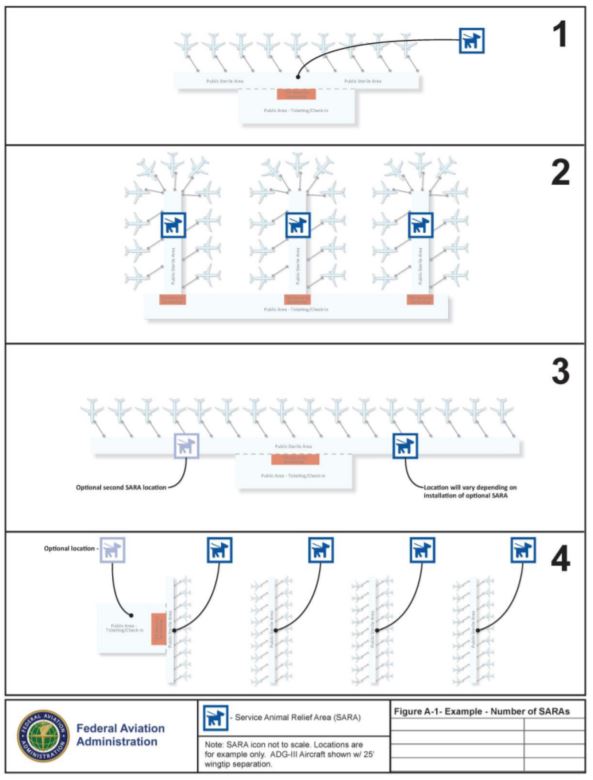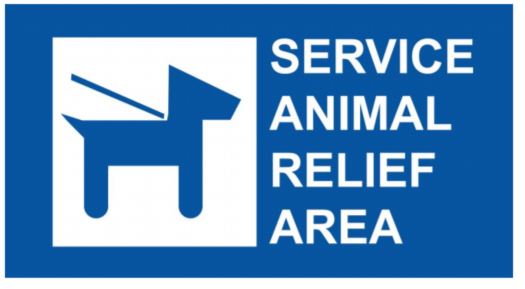Federal Aviation Administration Draft Advisory Circular 150/5360-14A, Access to Airports by Individuals with Disabilities
APPENDIX A. GUIDELINES FOR SERVICE ANIMAL RELIEF AREAS (SARA)
A.1 General.
A.1.1 As stated in Section 2.5.6.6 (per Title 49 Subpart B § 27.71 (h), Service Animal Relief Areas), each airport with 10,000 or more annual enplanements shall provide wheelchair-accessible Service Animal Relief Areas (SARAs) for service animals that accompany passengers departing, connecting, or arriving at airports.
A.1.2 The SARA standards below have been developed in collaboration with nationally recognized service animal training organizations and groups of users of service animals to assist airports with the installation of SARAs. In addition to the guidance below, airports must consult with one or more service animal training organizations regarding the design, dimensions, materials and maintenance of service animal relief areas.
A.2 Number.
A.2.1 At least one SARA must be located in each public sterile area of each terminal.
A.2.2 While a single SARA is required in each passenger terminal sterile area, additional optional SARAs are recommended based on the size or configuration of the sterile area (s) in a given terminal. A passenger with a service animal in a given sterile area should not have to travel excessive distances to reach a SARA or exit one sterile area and be reprocessed through another security checkpoint to reach a SARA. The goal is to improve accessibility to SARAs and provide a higher level of service for travelers and their service animals.
A.2.3 Example scenarios are as follows and correspond with the examples in Figure A-1:
-
A passenger terminal building with a single security checkpoint and sterile area is required to have a single SARA.
-
A passenger terminal building with multiple security checkpoints and/or separate public sterile areas is required to have at least one SARA for each public sterile area.
-
A passenger terminal building with either single or multiple security checkpoints and separate public sterile areas, but with excessive walking distances will be better served with multiple SARAs. Please note that providing additional SARAs beyond one per sterile area is recommended, but optional and at the discretion of the airport operator.
-
Multiple passenger terminal buildings will each require at least one SARA and will be better served as described in bullets (2) and (3).
Note: For additional clarification, airports are encouraged to coordinate with the FAA Offices of Airports and Civil Rights.
A.3 Size and shape.
The SARA may be of any shape, but must be designed to accommodate a person using a wheelchair handling a service animal on a six-foot leash. In busier locations, a relief area may be sized to accommodate more than one service animal at one time.
A.4 Surfaces.
A relief area should have at least two different surfaces. One should be hard and located immediately inside the entrance to allow wheelchair access. This surface should be delineated in a manner to indicate the portion intended to be traversed by people, and the portion intended for animal relief. The other should be an appropriate softer surface, such as gravel or mulch for outdoor areas, and artificial turf specially designed as an animal relief surface, treated to inhibit the spread of disease, for indoor (and outdoor) areas. Other artificial turf is not recommended, as it harbors odors and bacteria. Consider that artificial turf is often perceived as carpet by service animals, making them reluctant to use it. Avoid surfaces such as sand that will stick to paws and be tracked outside the SARA. When using mulch, be sure it is not of a species that can be harmful to animals. Dark colored surfaces should not be used where exposed to the sun, as they can become unbearably hot.
A.5 Fencing.
SARAs should be fenced or surrounded by another suitable enclosure adequate for containing animals and should be constructed with an accessible gate/entrance.
A.6 Plumbing.
SARAs should include a sink with a faucet for hand washing. When designing and installing the sink, airports should consider that users may use the sink to fill bowls for their service animal. A separate water supply should be included for use in cleaning the surface. The surface should be constructed with adequate drainage to facilitate regular cleaning. A hand sanitizer may be provided instead of sink.
A.7 Location.
There are a number of key factors that determine the location of a SARA:
1.The SARA must be located in the publicly accessible sterile area of each airport terminal, unless:
a. The Transportation Security Administration prohibits the airport from locating a relief area in the sterile area, or
b. A service animal training organization, the airport, and the carriers in the terminal in which the relief area will be located agree that a relief area would be better placed outside the terminal's sterile area. In that event, the airport must retain documentation evidencing the recommendation that the relief area be located outside of the sterile area.
2. The SARA must be wheelchair accessible.
3. Similar to siting typical restrooms, a best practice is to choose a location that is proximate and conveniently accessible to concentrations of passengers (e.g., central circulation corridors, hold rooms, and or major concession concentrations).

Figure A-1. SARA Signage
A.8 Weather Protection.
Outdoor SARA should include weather protection from sun and precipitation. If the SARA is close to operating aircraft, protection from jet blast and prop wash should be provided.
A.9 Scent.
Because animals have a more acute sense of smell than humans, pheromone-scented surfaces or devices may encourage service animals to use the SARA, while disinfecting chemicals with strong odors may serve as a deterrent.
A.10 Accessories.
The SARA, at a minimum, should include:
-
A three-dimensional prop (e.g. rock or fake fire hydrant) to encourage urination by male dogs. Ensure that the prop is positioned in a location inside the SARA that will not obstruct a wheelchair user’s entrance into, or maneuverability inside the SARA.
-
Disposable animal waste bags.
-
A waste receptacle.
Note: Disposal bags and waste receptacles should be located just inside the entrance to the SARA on an accessible route and at a height reachable by wheelchair users.
A.11 Wayfinding and Signage
A.11.1 Signage Standardization is Desirable.
The sign shown in Figure A-2, signage may be used with or without accompanying text or directional arrows to guide users to the SARA. The signage, when used, should be included in airport layout maps and in wayfinding instructions provided throughout the airport. In addition, signing at the SARA should indicate the following:
-
The need for handlers to clean up after animals;
-
The location of waste disposal bags, and waste receptacles, hand washing facilities, and any other facilities (e.g. automatic flushing controls);
-
Instructions for the operation of any facilities; and
-
Contact information for maintenance and assistance.
A.11.2 Other Guidance.
Signage should be supplemented with a means, including auditory announcements, to guide people with vision impairments, i.e. auditory announcements. Braille signage should be installed adjacent to the side of doors and gates opposite the hinges. Airports are encouraged to adopt up-to-date technology (e.g., smart phone applications) as it becomes available.
Figure A-2. Example SARA Signage


User Comments/Questions
Add Comment/Question